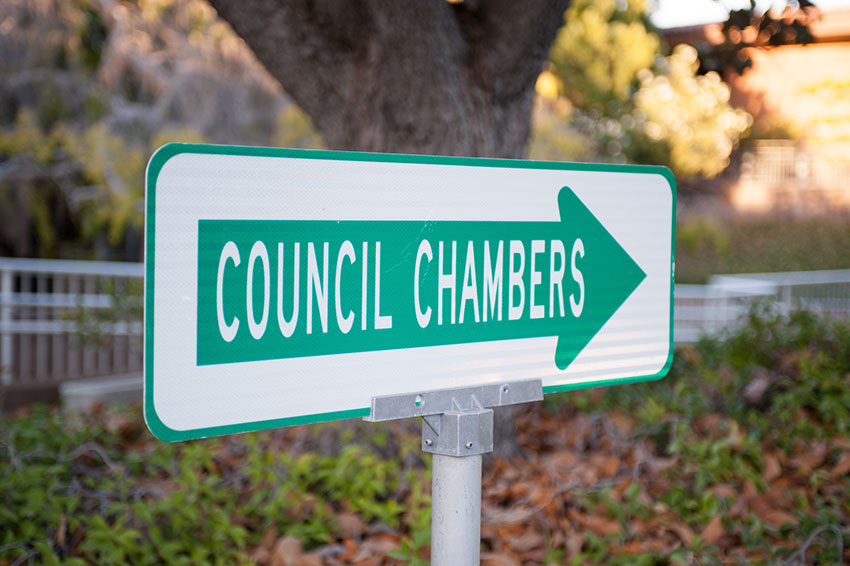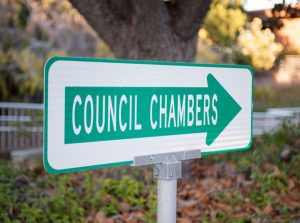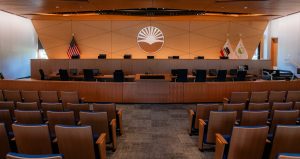Despite many changes, several members of the public still oppose a massive high-density apartment development set to be located on Coleman Avenue.
Dubbed “Gateway Crossings,” the latest iteration of complex, located at 1205 Coleman Ave., will house 1,600 apartments, 25,000 square feet of retail space and a 225-room hotel. The developer, Hunter Properties, made changes to the project after tide of public opposition in late 2018 and returned to the Santa Clara City Council for approval Tuesday night.
Among the changes was the addition of 10,000 square feet of retail and more than 36,000 square feet of amenity space. The new plans also call for a new clubhouse for Police Athletic League.
However, the changes weren’t enough for naysayers who turned out Tuesday, most of whom live in the Old Quad. Most of the criticism aimed at the development was that the retail space was sorely lacking and that the development typifies what many called a “piecemeal” approach that has worked poorly for Santa Clara in the past.
“This project does not show where Santa Clara is going but where it has been,” said Adam Thompson, a resident of the Old Quad. “I fear that it will become the urban renewal mistake of our time.”
Several speakers echoed Thompson’s sentiments, saying they feared, because of its size, once erected the development would become too rigid, making it difficult to adjust to community needs. Many speakers said the project needs to be a “walkable urban village” that makes the most of its proximity to the train station.
Jonathan Evans, Vice President of Old Quad Residents Association, said the development “underuses” one of the City’s “most valuable parcels.” Moving forward with this iteration of the project is “setting the City up for costly mistakes,” he added.
Another speaker, Patricia Leung, said that during public outreach on the project, representatives from Hunter Properties frequently fell victim to a “self-imposed sunk cost fallacy.”
“This does not represent the center of what’s possible,” she said, referencing Santa Clara’s mantra. “This represents the center of checking boxes.”
Amy Peabody Ingram called the Gateway Crossings a “cookie-cutter business park” that “puts money in the pocket of developers” and will fail to revive downtown.
Still, not everyone opposed the project. Some, while they conceded the project is far from perfect, saw a sense of urgency in adding much-needed housing, something the Council has continually espoused as a priority.
“A development like this really sets Silicon Valley apart from the rest of the county,” said Matthew McNamara.
Mayor Lisa Gillmor supported the project, saying she understands market demand and that forcing developers to include elements that are not driven by market demand is a recipe for disaster.
“We really have to look at reality,” she said.
After much discussion, the Council opted to postpone the vote, continuing the conversation to its July 9 meeting.
Massive Subsidies Drive Decisions About User-Fee Cost Recovery
The Council considered adjusting user fees after an audit showed the City is not collecting about $20.5 million in fees. Since only 44 percent of user fees are recovered Citywide, the Council will need to make decisions on a new fee schedule and determine which departments have acceptably low cost recovery.
The consulting firm that presented to the Council, Matrix Consulting Group, suggested having recovery goals for each department. Since many departments are often seen as having large community benefit, such as Parks and Recreation, have low cost recovery — 17 percent in Santa Clara’s case — the Council will need to determine how to adjust the user fee schedule to balance fiscal responsibility with community benefit.
Gillmor said she doesn’t like a “one size fits all” approach to user fees, saying that services that enhance “quality of life” should not be held to a high cost-recovery standard.
City Manager Deanna Santana said the revised fee schedule should be in place between September and October.
New Contracts for City Services, Rate Increases
The food and beverage provider at the Convention Center will change. The City has terminated its contract with Aramark, the Convention Center’s current food and beverage provider, and sent out a request for proposal on a new provider.
Ruth Shikada, Assistant City Manager, said the City is seeking a five-year contract and will embed performance standards similar to those in the management agreement.
“We want to change the way we have been doing business,” she said.
The Council also renewed contracts for solid waste removal and recycling for residential and industrial customers. Industrial franchise fees put nearly $2 million into the general fund each year.
Dave Staub, Deputy Director of Public Works, said he was “astonished” to learn that an audit of industrial recycling showed only 4 percent of customers complied with the mandatory recycling and organics program.
Because the audit also showed that the City had nearly $300,000 in missed user fee revenue over the past couple years, Staub said the City is proposing a 12 percent flat rate for franchise solid waste providers, which he said is “simpler.”
Rates for solid waste removal for residential also increased from between 7.3 percent and 9.2 percent, depending on the size of the resident’s bin. Commercial rates increased by 4 percent or 5.8 percent.
Staub said the rate increase is due to an increase in overhead, namely a mandatory cost of living adjustment and new management system.
Capital improvements to the tune of $146 million over the next five years will also cause water rates to increase, Gary Welling, Director of Water and Sewer Utilities, said. The potable water rate increased from $5.98/hundred cubic feet to $6.22/hundred cubic feet.
The new rates go into effect July 1.
New Board Aims to Promote City
In order to better market the City to outsiders, the Council also discussed establishing a board designed to do just that. Known as a “destination marketing organization,” the board would have representatives from the hotel industry, organized labor, the City and developers.
The board would need its own attorney — separate from the City Attorney — and would establish its own bylaws. The Council voted unanimously to establish the board but specified that it wanted another representative from organized labor (the proposal contained only one) and a tech company represented.
Council Selects Another Planning Commissioner
With another vacancy on the Planning Commission, the Council also appointed another commissioner.
Having already appointed a Planning Commissioner this year, the Council opted during that appointment in April to, should another vacancy occur, to select from the frontrunners for the previous appointment.
Considering the top three candidates, the Council selected Jayapriya Cherukuru in a 5-2 vote. Cherukuru is a capital projects manager for Santa Clara County and serves on the Historical Landmarks Commission.
The Council meets again June 4 in the Council Chambers at City Hall, 1500 Warburton Ave. in Santa Clara.












0 comments